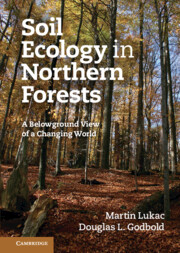Book contents
- Frontmatter
- Contents
- Preface
- 1 Introduction
- 2 Soil properties
- 3 Forest soil development and classification
- 4 Soil fungi
- 5 Soil water
- 6 Forest carbon cycle
- 7 Nutrient cycling
- 8 Northern forests in a high-CO2 world
- 9 Soil acidity and heavy metal pollution
- 10 Nitrogen
- 11 Soil functioning and climate change
- References
- Index
- Plate section
6 - Forest carbon cycle
Published online by Cambridge University Press: 26 April 2011
- Frontmatter
- Contents
- Preface
- 1 Introduction
- 2 Soil properties
- 3 Forest soil development and classification
- 4 Soil fungi
- 5 Soil water
- 6 Forest carbon cycle
- 7 Nutrient cycling
- 8 Northern forests in a high-CO2 world
- 9 Soil acidity and heavy metal pollution
- 10 Nitrogen
- 11 Soil functioning and climate change
- References
- Index
- Plate section
Summary
All life found in the biosphere is based on a common carrier of energy: carbohydrate chains. With the exception of organic matter produced by thermo-bacteria, the origin of all biomass found in the biosphere can be traced to photosynthesis. This biochemical process where carbon dioxide, water and energy from sunlight are combined into organic molecules places all biological activity firmly at the centre of the global carbon cycle. The carbon in atmospheric CO2 is ‘fixed’ into organic matter by photosynthesis in autotrophic organisms (primary producers) and becomes both a building block and an energy source for all life forms. To free the energy held in organic molecules, both autotrophic and heterotrophic (consumer) organisms break down the carbohydrate chains, returning most of the assimilated carbon back into the atmosphere as CO2. The route of each carbon atom through the biosphere can be very diverse and can vary greatly in length. Some CO2 molecules are incorporated into simple sugars and then broken down nearly immediately to power the metabolism of the leaf that assimilated them, their passage from atmosphere, through biosphere and back into the atmosphere lasting just a brief moment. Other CO2 molecules, on the other hand, are assimilated in the forest canopy and passed down a long chain of organisms, eventually becoming part of soil humus, where they may remain locked for millennia.
- Type
- Chapter
- Information
- Soil Ecology in Northern ForestsA Belowground View of a Changing World, pp. 94 - 117Publisher: Cambridge University PressPrint publication year: 2011



